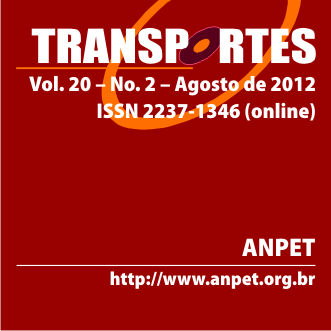Viscosidade rotacional de ligantes asfálticos modificados de mesmo grau de desempenho
DOI:
https://doi.org/10.4237/transportes.v20i2.560Abstract
Os objetivos deste trabalho são (a) comparar as viscosidades rotacionais de ligantes asfálticos de mesmo PG e nas condições virgem e modificada, (b) comparar as temperaturas de processamento obtidas por métodos diferentes e (c) avaliar o efeito das temperaturas de processamento adotadas para estas amostras sobre os teores ótimos das misturas dosadas pelo critério do Superpave. As maiores viscosidades pertencem ao CAP+EVA, ao CAP+borracha e ao CAP+borracha+PPA e as menores, ao CAP puro e ao CAP+PPA. As temperaturas de processamento calculadas pelo método tradicional se mostraram muito elevadas para o CAP+borracha, o CAP+borracha+PPA e o CAP+EVA e, pelo método simplificado, estas temperaturas são de 20 a 45 °C menores para a maioria dos ligantes asfálticos. À exceção do CAP puro, do CAP+PPA, do CAP+SBS+PPA e do CAP+EVA+PPA, as temperaturas de processamento da maioria dos ligantes asfálticos foram reduzidas e, mesmo assim, os projetos de dosagem das misturas asfálticas pelo método Superpave foram bem-sucedidos.
Palavras-chave: viscosidade rotacional, grau de desempenho, ligantes asfálticos modificados, temperaturas de usinagem e compactação, compactador giratório.
Abstract: The objectives of this paper are the following: (a) to compare rotational viscosities of unaged and modified asphalt binders with the same performance grade, (b) to compare mixing and compaction temperatures obtained by different methods and (c) to evaluate the effect of these temperatures on the optimum binder contents of mixes designed according to the Superpave criterion. AC+EVA, AC+rubber and AC+rubber+PPA have the greatest viscosities among the binders studied here, whereas the neat one and AC+PPA have the lowest viscosities. Mixing and compaction temperatures were found to be very high for AC+rubber, AC+rubber+PPA and AC+EVA in the conventional method, whereas temperatures from 20 to 45 °C lower were found for the majority of the binders in the simple method. Mixing and compaction temperatures were reduced for the majority of the binders with the exception of the neat binder, AC+PPA, AC+SBS+PPA and AC+EVA+PPA. In spite of these reductions, the Superpave mixture design projects were well succeeded.
Keywords: rotational viscosity, performance grade, modified asphalt binders, mixing and compaction temperatures, gyratory compactor.
Downloads
Downloads
Published
How to Cite
Issue
Section
License
Authors who submit papers for publication by TRANSPORTES agree to the following terms:
- The authors retain the copyright and grant Transportes the right of first publication of the manuscript, without any financial charge, and waive any other remuneration for its publication by ANPET.
- Upon publication by Transportes, the manuscript is automatically licensed under the Creative Commons License CC BY 4.0 license. This license permits the work to be shared with proper attribution to the authors and its original publication in this journal.
- Authors are authorized to enter into additional separate contracts for the non-exclusive distribution of the version of the manuscript published in this journal (e.g., publishing in an institutional repository or as a book chapter), with recognition of the initial publication in this journal, provided that such a contract does not imply an endorsement of the content of the manuscript or the new medium by ANPET.
- Authors are permitted and encouraged to publish and distribute their work online (e.g., in institutional repositories or on their personal websites) after the editorial process is complete. As Transportes provides open access to all published issues, authors are encouraged to use links to the DOI of their article in these cases.
- Authors guarantee that they have obtained the necessary authorization from their employers for the transfer of rights under this agreement, if these employers hold any copyright over the manuscript. Additionally, authors assume all responsibility for any copyright infringements by these employers, releasing ANPET and Transportes from any responsibility in this regard.
- Authors assume full responsibility for the content of the manuscript, including the necessary and appropriate authorizations for the disclosure of collected data and obtained results, releasing ANPET and Transportes from any responsibility in this regard.










